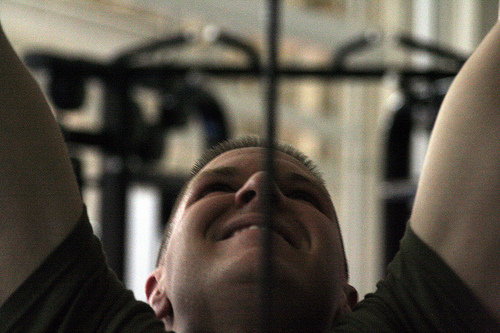- You are here:
- Home »
- Blog »
- Training »
- What muscles do pull-ups work?
What muscles do pull-ups work?

Photo By: Hector Alejandro
One of the best exercises for displaying and improving upper body strength is the pull-up. They can build muscular size and strength in the upper back and arms and force the core to be activated for stabilization. But exactly what muscles do pull-ups work?
- Muscles directly worked – latissimus dorsi (lats), biceps
- Muscles indirectly worked – rear delts, rhomboids, trapezius (traps), core
While these are not the only muscle used in a pull-up, they are the most important. In non-technical terms, it is basically the upper back and the arms, with plenty of other muscles for assistance and the core for stabilization. The lats are usually the primary target of pull-up work as they are one of the best exercises for building thick and wide lats.
Pull-ups can be very challenging for new lifters or people who are overweight. That is because they have to be able to lift up the weight of their entire body using only their upper body muscles. Even experienced athletes who are on the heavy side may struggle to perform this lift. Grip strength is another thing tested by this exercise.
You can see a demonstration of proper pull-up technique below. A good pull-up consists of a stable body, not swinging. You simply grab the bar and pull up from there. You should go straight up and down, with no extra movements. Swinging your body can make this easier, but that is cheating and could lead to injury.
You can mix it up and perform both wide-grip and close-grip versions. The different grips work the target muscles in different ways. In general a closer grip will hit the biceps and arms overall more. A wider grip will require more work from the back.
So we’ve established that pull-ups are great, but what if you can’t do any? There are several alternatives to pull-ups. These can be used for at least 3 different reasons. First, if there is a health or injury issue that prevents you from being able to perform a proper pull-up. Secondly, if you do not have the strength levels needed to pull yourself up. And finally, if you have been doing pull-ups consistently for too long and need to switch up exercises.
If you are doing pull-ups to build strength or muscles, you’ll want to do exercises that both the upper back and the biceps. These exercises generally will hit all the same supporting muscles as pull-ups, although if a seated version is used, the core will have less stabilization work.
The video below demonstrates the lat pulldown exercise. This is very similar to a pull-up, but a cable machine is used as is a seated position. The machine aspect of it allows you to vary the weight. This allows you to use a significantly lighter resistance than the entire body would create.
Lat pulldowns are great for beginners and experienced lifters because they hit all the targets muscles but are easier to do. If you want to get volume in and really increase muscle size, you can do these with a lighter resistance. Most machines have the ability to do incremental increases, such as 10 pounds at a time. This allows you to progressively overload your body and increase strength.
The seated cable row is another exercise that is great for developing the lats and improving overall upper body strength. Being that it is another common machine, it has many of the same benefits of the lat pulldown. The difference is that this hits the muscles from a different angle.
The cable row is performed in a seated position with the weight out in front of you. Using good, upright posture, the weight is pulled towards the chest. This can also be done with a close or wide grip with any crazy attachments you have in your gym. This does work the biceps, but it really targets the entire upper back.
Pull-ups target the upper back and biceps muscles. They are one of the best overall size and strength exercises for those areas. While a pull-up is a great measure of one’s upper body strength, they are not the only exercise that serves that purpose and mixing in unique exercises and rep schemes will allow you to continue to progress.

